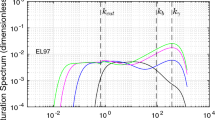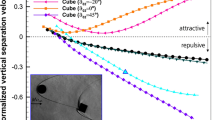Abstract
This paper aims at solving Zermelo’s navigation problem on conformally flat Riemannian manifolds admitting a ship’s variable self-speed, under the action of arbitrary winds including space and time dependence for both perturbation and ship’s speed. Our approach is a variational one under application of the Euler–Lagrange equations with reference to the initial studies of this problem. First of all, we distinguish the navigation cases in non-critical, i.e. weak or strong, and critical winds, which are then unified into an arbitrary wind. After having considered the second variation of a given functional, we obtain the conditions for both time-minimal, i.e. the typical solutions to Zermelo’s problem, and time-maximal extremals. The anomalous paths are also emphasized. Moreover, some classification results are presented with respect to the kinds of perturbation considered separately and under an arbitrary wind. This study is illustrated at its end by a two-dimensional example including a prolate ellipsoid in the presence of a rotational vector field, wherein the solution types are being compared.

Similar content being viewed by others
References
Zermelo, E.: Über die Navigation in der Luft als Problem der Variationsrechnung. Jahresber. Deutsch. Math.-Verein. 89, 44–48 (1930)
Zermelo, E.: Über das Navigationsproblem bei ruhender oder veränderlicher Windverteilung. ZAMM-Z. Angew. Math. Mech. 11(2), 114–124 (1931)
Shen, Z.: Finsler metrics with \(\mathbf{K}=0\) and \(\mathbf{S}=0\). Can. J. Math. 55(1), 112–132 (2003). https://doi.org/10.4153/CJM-2003-005-6
Bao, D., Robles, C., Shen, Z.: Zermelo navigation on Riemannian manifolds. J. Differ. Geom. 66(3), 377–435 (2004)
Aldea, N.: Zermelo deformation of Hermitian metrics by holomorphic vector fields. Results Math. 75, 140 (2020). https://doi.org/10.1007/s00025-020-01270-9
Aldea, N., Kopacz, P.: Generalized Zermelo navigation on Hermitian manifolds under mild wind. Differ. Geom. Appl. 54PA, 325–343 (2017)
Aldea, N., Kopacz, P.: Generalized Zermelo navigation on Hermitian manifolds with a critical wind. Results Math. 72, 2165–2180 (2017). https://doi.org/10.1007/s00025-017-0757-6
Aldea, N., Munteanu, G.: Projectively related complex Finsler metrics. Nonlinear Anal.-Real 13(5), 2178–2187 (2012)
Kopacz, P.: On generalization of Zermelo navigation problem on Riemannian manifolds. Int. J. Geom. Methods Mod. Phys. 16(4), 19500580 (2019). https://doi.org/10.1142/S0219887819500580
Kopacz, P.: A note on generalization of Zermelo navigation problem on Riemannian manifolds with strong perturbation. An. Sti. U. Ovid. Co.-Mat. 25(3), 107–123 (2017). https://doi.org/10.1515/auom-2017-0039
Caponio, E., Javaloyes, M.A., Sánchez, M.: Wind Finslerian structures: from Zermelo’s navigation to the causality of spacetimes. arXiv:1407.5494 [math.DG] (2015)
Brody, D.C., Gibbons, G.W., Meier, D.M.: Time-optimal navigation through quantum wind. New J. Phys. 17, 033048 (2015)
Russell, B., Stepney, S.: Zermelo navigation in the quantum brachistochrone. J. Phys. A Math. Theor. 48(11), 115,303 (2015). https://doi.org/10.1088/1751-8113/48/11/115303
Kopacz, P.: Application of planar Randers geodesics with river-type perturbation in search models. Appl. Math. Model. 49, 531–553 (2017). https://doi.org/10.1016/j.apm.2017.05.007
Kopacz, P.: A note on time-optimal paths on perturbed spheroid. J. Geom. Mech. 10(2), 139–172 (2018). https://doi.org/10.3934/jgm.2018005
Javaloyes, M.A., Sánchez, M.: On the definition and examples of cones and Finsler spacetimes. Rev. R. Acad. Cienc. Exactas Fís. Nat. Ser. A Mat. RACSAM 114, 30–46 (2020)
Levi-Civita, T.: Über Zermelo’s Luftfahrtproblem. ZAMM-Z. Angew. Math. Mech. 11(4), 314–322 (1931)
Carathéodory, C.: Calculus of Variations and Partial Differential Equations of the First Order. American Mathematical Society, Chelsea Publishing (1935 (reprint 2008))
De Mira Fernandes, A.: Sul problema brachistocrono di Zermelo. Rendiconti della R. Acc. dei Lincei XV(4), 47–52 (1932)
Arrow, K.J.: On the use of winds in flight planning. J. Meteorol. 6, 150–159 (1949)
Pontryagin, L.S., Boltyanskii, V.G., Gamkrelidze, R.V., Mishchenko, E.F.: The Mathematical Theory of Optimal Processes. Interscience, New York (1962)
Agrachev, A.A., Sachkov, Y.L.: Control Theory from the Geometric Viewpoint. Encyclopaedia of Mathematical Sciences, 87. Springer, Berlin (2004)
Burns, J.A.: Introduction to the Calculus of Variations and Control with Modern Applications. Applied Mathematics and Nonlinear Science Series. CRC Press, Boca Raton (2013)
Hull, D.G.: Optimal Control Theory for Applications. Mechanical Engineering Series. Springer, Berlin (2009)
Levi, M.: Classical Mechanics with Calculus of Variations and Optimal Control: An Intuitive Introduction, Student Mathematical Library, vol. 69. American Mathematical Society, Philadelphia (2014)
Paiva, E., Pereira, G.: Optimal Aerial Guidance in General Wind Fields. TechRxiv. Preprint. https://doi.org/10.36227/techrxiv.13172915.v1 (2020)
Jardin, M.R., Bryson Jr., A.E.: Methods for computing minimum-time paths in strong winds. J. Guid. Control Dyn. 35(1), 165–171 (2012). https://doi.org/10.2514/6.2010-8398
Bryson Jr., A.E., Ho, Y.C.: Applied Optimal Control: Optimization, Estimation and Control. Hemisphere Publishing Corporation, Washington (1975)
Bijlsma, S.J.: Optimal aircraft routing in general wind fields. J. Guid. Control Dyn. 32(3), 1025–1028 (2009). https://doi.org/10.2514/1.42425
Serres, U.: On Zermelo-like problems: Gauss–Bonnet inequality and E. Hopf theorem. J. Dyn. Control Syst. 15(1), 99–131 (2009). https://doi.org/10.1007/s10883-008-9056-6
Techy, L.: Optimal navigation in a planar time-varying point-symmetric flow-field. In: 50th IEEE Conference on Decision and Control and European Control Conference, pp. 7325–7330. IEEE, Orlando, FL (2011)
Bijlsma, S.J.: A computational method for the solution of optimal control problems in ship routing. Navig. Jo. Inst. Navig. 48(3), 145–154 (2001). https://doi.org/10.1002/j.2161-4296.2001.tb00238.x
Oberle, H.J., Rosendahl, R.: On singular arcs in nonsmooth optimal control. Control Cybern. 37(2), 429–450 (2008)
Marchidan, A., Bakolas, E.: Numerical techniques for minimum-time routing on sphere with realistic winds. J. Guid. Control Dyn. 39(1), 188–193 (2016). https://doi.org/10.2514/1.G001389
Kühnel, W.: Differential Geometry: Curves—Surfaces—Manifolds, Student Mathematical Library, vol. 77. American Mathematical Society, Philadelphia (2015)
Paláček, R., Krupková, O.: On the Zermelo problem in Riemannian manifolds. Balk. J. Geom. Appl. 17(2), 77–81 (2012)
Yoshikawa, R., Sabau, S.V.: Kropina metrics and Zermelo navigation on Riemannian manifolds. Geom. Dedicata 171(1), 119–148 (2013)
Hays, G.C., Christensen, A., Fossette, S., Schofield, G., Talbot, J., Mariani, P.: Route optimisation and solving Zermelo’s navigation problem during long distance migration in cross flows. Ecol. Lett. 17(2), 137–143 (2014)
Chapman, J.W., Klaassen, R.H.G., Drake, V.A., Fossette, S., Hays, G.C., Metcalfe, J.D., Reynolds, A.M., Reynolds, D.R., Alerstam, T.: Animal orientation strategies for movement in flows. Curr. Biol. 21(20), 861–870 (2011)
Weintrit, A., Kopacz, P.: A novel approach to Loxodrome (Rhumb Line), Orthodrome (Great Circle) and geodesic line in ECDIS and navigation in general. TransNav Int. J. Mar. Navig. Safe. Sea Transportation 5(4), 507–517 (2011)
Ito, K., Reisinger, C., Zhang, Y.: A neural network-based policy iteration algorithm with global \(H^2\)-superlinear convergence for stochastic games on domains. Found. Comput. Math. (2020). https://doi.org/10.1007/s10208-020-09460-1
Anderson, R.P., Bakolas, E., Milutinovic, E., Tsiotras, P.: Optimal feedback guidance of a small aerial vehicle in a stochastic wind. J. Guid. Control Dyn. 36(4), 975–985 (2013)
Esfahani, P.M., Chatterjee, D., Lygeros, J.: The stochastic reach-avoid problem and set characterization for diffusions. Automatica 70, 43–56 (2016)
Bao, D., Chern, S.S., Shen, Z.: An Introduction to Riemann–Finsler Geometry. Springer, Berlin (2000)
Acknowledgements
The authors wish to express their gratitude to the reviewers for several helpful comments. During the final stage of the work, the second author was partially supported by the Gdynia Maritime University project reference WN/2020/PI/02.
Author information
Authors and Affiliations
Corresponding author
Ethics declarations
Conflict of interest
The authors declare that they have no conflict of interest.
Additional information
Communicated by Anil V. Rao.
Publisher's Note
Springer Nature remains neutral with regard to jurisdictional claims in published maps and institutional affiliations.
Appendices
Appendix A
We sketch below a technical roadmap for the extension of time-extremal navigation to arbitrary Riemannian manifolds as a background space in the presence of arbitrary winds.
Let (M, h) be a Riemannian manifold of dimension n, where \( h=h_{ij}\hbox {d}x^{i}\otimes \hbox {d}x^{j}\) is a Riemannian metric determined by the components \(h_{ij}(x)=h(\frac{\partial }{\partial x^{i}},\frac{\partial }{ \partial z^{j}})\) in the local coordinates \((x^{1},\ldots ,x^{n})\) of \(x\in M.\) The length of a tangent vector \(v\in T_{x}M\) is denoted by \(\left| v\right| _{h}=\sqrt{h(v,v)}=\sqrt{h_{ij}v^{i}v^{j}}\). Substituting \(u=v {-}W\) into \(f=|u|_{h}=\sqrt{h(u,u)}\), it results that \(|u|_{h}=\sqrt{ |v|_{h}^{2}-2h(v,W)+|W|_{h}^{2}}\). Thus, the last relation can be rewritten as
with \(\lambda :=f^{2}-|W|_{h}^{2}.\) Since the resulting velocity v is the tangent vector to the trajectory \((x^{1}(t),\ldots ,x^{n}(t))\) and \(v^{i}~=~{\dot{x}}^{i}(t)=\frac{\hbox {d}x^{i}}{\hbox {d}t},\) \(\hbox {d}s=\left| v\right| _{h}\hbox {d}t,\) where \(s=s(t)\) is the arc length function. Moreover, using the notation \( L_{d}(x,\hbox {d}x,t):=\hbox {d}t\), it yields the equivalent form of Eq. (51), that is,
where \(W_{i}:=h_{ij}W^{j}\). This corresponds to Eq. (5), for arbitrary Riemannian metric h. Following the same way and arguments like in Sect. 3, Eq. (52) leads to the \(C^{\infty }\) homogeneous Lagrangian \(L(x,{\dot{x}},t):=\frac{1 }{\hbox {d}t}L_{d}(x,\hbox {d}x,t)\) in arbitrary variables x, \({\dot{x}}:=\frac{\hbox {d}x}{\hbox {d}t}\) and t. It is a positive root of the equation
and it satisfies \(L(x(t),{\dot{x}}(t),t)=1\) along the curves given by the equations of motion (3). The explicit equations for optimal navigation with arbitrary Riemannian metric h, which generalize Eq. (23), can be obtained by developing the Euler–Lagrange equations (11) corresponding to the Lagrangian L from Eq. (53). For example, for space-dependent perturbations of arbitrary force \(|W|_{h}\) and unit self-speed (\(|u|_{h}=1\)), the time-extremal solutions to the navigation problem on (M, h) are determined by the differential system consisting of the general optimality condition
and Eq. (3), if \(1+W_{k}u^{k}\ne 0,\) where \(\varGamma _{jk}^{i}\) are the Christoffel symbols of h and \(W_{j|k}:=\frac{\partial W_{j}}{\partial x^{k}}-W_{l}\varGamma _{jk}^{l}\).
Appendix B: Proof of Proposition 4.2
We make use of Proposition 11.2.1 from [44, p.287], that is,
Proposition B.1
[44] Suppose \((Q_{ij})\) is a non-singular \(n\times n\) complex matrix with inverse \((Q^{ij}),\) \(C_{i},\) \(i=1,\ldots ,n\) are complex numbers, \(C^{i}:=Q^{ij}C_{j}\), \(C^{2}:=C^{i}C_{i}\) and \(G_{ij}:=Q_{ij}+ \varepsilon C_{i}C_{j},\) with \(\varepsilon \) a constant. Then
-
1.
\(\det (G_{ij})=(1+\varepsilon C^{2})\det (Q_{ij})\),
-
2.
whenever \(1+\varepsilon C^{2}\ne 0,\) the matrix \((G_{ij})\) is invertible and in this case its inverse is \(G^{ij}=Q^{ij}-\frac{\varepsilon }{1+\varepsilon C^{2}}C^{i}C^{j}.\)
In order to justify our claim, first of all, we need to solve the following equation
Denoting \(E_{ij}:=H_{ij}(x(t),{\dot{x}}(t),t)-r\delta _{ij},\) we apply Proposition B.1 in a recursive algorithm in three steps. We write \(E_{ij}\) in the form
Step 1. We set \(Q_{ij}:=\delta _{ij},\) \(\varepsilon :=\frac{ \rho ^{2}}{f(\rho -rf)}\) and \(C_{i}:=W^{i}.\) We obtain \(Q^{ij}=\delta _{ij}\), \(C^{i}=W^{i}\), \( C^{2}=S^{2}|W|_{h}^{2}\) and \(1+\varepsilon C^{2}=\frac{(\lambda +p)(\rho -rf)+\rho |W|_{h}^{2}}{(\lambda +p)(\rho -rf)}.\) So, the matrix \( G_{ij}=\delta _{ij}+\frac{\rho ^{2}}{f(\rho -rf)}W^{i}W^{j}\) is invertible, with \(G^{ij}=\delta _{ij}-\frac{\rho }{S^{2}X}W^{i}W^{j}\) and the determinant \(\det \left( \delta _{ij}+\frac{\rho ^{2}}{f(\rho -rf)}W^{i}W^{j}\right) = \frac{X}{(\lambda +p)(\rho -rf)},\) where \(X:=(\lambda +p)(\rho -rf)+\rho |W|_{h}^{2}.\)
Step 2. Now, we consider \(Q_{ij}:=\delta _{ij}+\frac{\rho ^{2}}{f(\rho -rf)} W^{i}W^{j},\) \(\varepsilon :=\frac{\rho ^{2}}{f(\rho -rf)}\) and \(C_{i}:={\dot{x}}^{i}\). Having applied Proposition B.1 again, it gives \(Q^{ij}=\delta _{ij}-\frac{\rho }{S^{2}X}W^{i}W^{j},\) \(C^{i}={\dot{x}}^{i}- \frac{\rho p}{X}W^{i},\) \(C^{2}=\frac{S^{2}(|v|_{h}^{2}X-\rho p^{2})}{X}\) and \(1+\varepsilon C^{2}=\frac{X(\lambda +p)(\rho -rf)-\rho (|v|_{h}^{2}X-\rho p^{2})}{X(\lambda +p)(\rho -rf)}\ne 0.\) These imply the existence of the inverse of \(G_{ij}=\delta _{ij}+\frac{\rho ^{2}}{f(\rho -rf)}W^{i}W^{j}-\frac{\rho ^{2}}{f(\rho -rf)}{\dot{x}}^{i}{\dot{x}} ^{j}\). Namely, \(G^{ij}=\delta _{ij}-\frac{\rho }{S^{2}X}W^{i}W^{j}-\frac{\rho X}{S^{2}Y} \left( {\dot{x}}^{i}-\frac{\rho p}{X}W^{i}\right) \left( {\dot{x}}^{j}-\frac{ \rho p}{X}W^{j}\right) \) and the determinant
where \(Y:=X(\lambda ~+~p) (\rho -rf)-\rho (|v|_{h}^{2}X-\rho p^{2}).\)
Step 3. Finally, we put \(Q_{ij}:=\delta _{ij}+\frac{\rho ^{2}}{f(\rho -rf)} W^{i}W^{j}-\frac{\rho ^{2}}{f(\rho -rf)}{\dot{x}}^{i}{\dot{x}}^{j}+\frac{pf\rho ^{2}}{(\lambda +p)(\rho -rf)}\alpha _{i}\alpha _{j}\), \(\varepsilon :=\frac{ pf\rho ^{2}}{(\lambda +p)(\rho -rf)}\) and \(C_{i}:=\alpha _{i}.\) We obtain \(Q^{ij}=\delta _{ij}-\frac{\rho }{S^{2}X}W^{i}W^{j}-\frac{\rho X}{S^{2}Y} \left( {\dot{x}}^{i}-\frac{\rho p}{X}W^{i}\right) \left( {\dot{x}}^{j}-\frac{ \rho p}{X}W^{j}\right) \). By computation, it reads \(1+\varepsilon C^{2}=1+\varepsilon Q^{ij}C_{i}C_{j}=\frac{r}{Y}(r-\frac{\rho f|v|_{h}^{2}}{(\lambda +p)^{2}}).\) So,
Thus, we get
Our claim immediately results therefrom. \(\square \)
Rights and permissions
About this article
Cite this article
Aldea, N., Kopacz, P. Time-Extremal Navigation in Arbitrary Winds on Conformally Flat Riemannian Manifolds. J Optim Theory Appl 189, 19–45 (2021). https://doi.org/10.1007/s10957-021-01818-x
Received:
Accepted:
Published:
Issue Date:
DOI: https://doi.org/10.1007/s10957-021-01818-x
Keywords
- Time-optimal
- Zermelo’s navigation problem
- Euler–Lagrange equations
- Second variation
- Conformally flat Riemannian manifold




